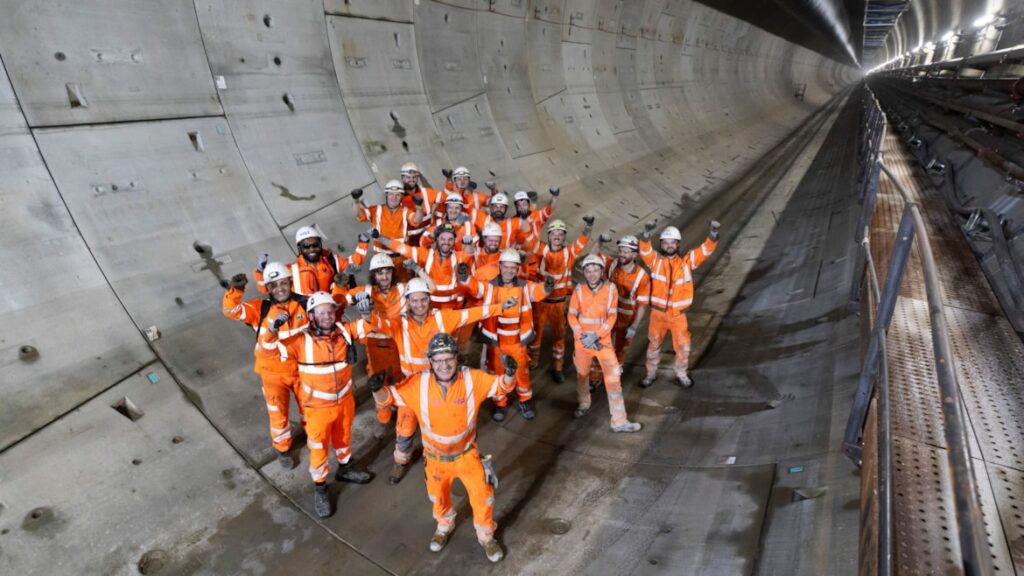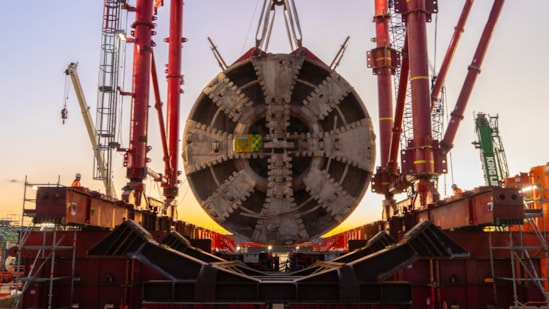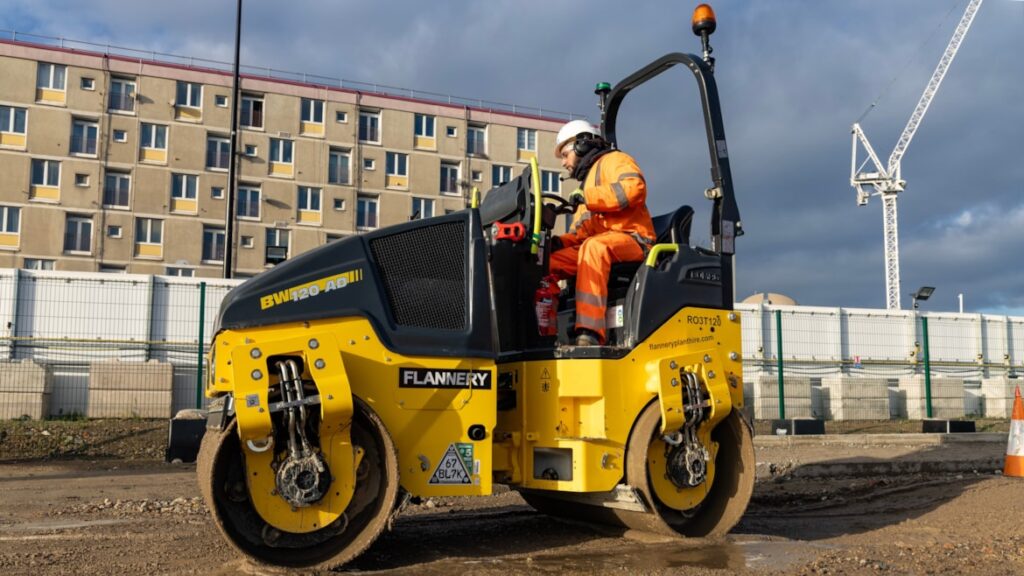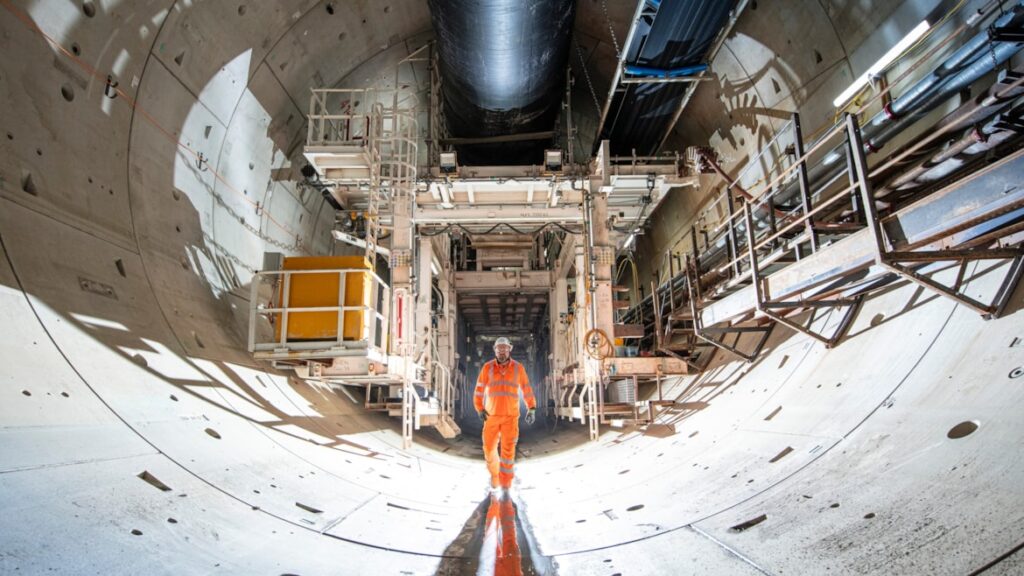Construction of the giant network of tunnels for HS2 has now passed the halfway point, marking a significant milestone for Britain’s new high-speed line.
HS2, which is at peak construction, supporting more than 31,000 jobs, has now completed excavation of two of its five twin-bore tunnels, with a further two well underway.
It underlines the scale of the progress being made on the line which is being constructed at 350 separate worksites between London and the West Midlands.
In total, high-speed trains will travel through 27.4 miles of twin-bore tunnels – or almost a fifth of the 140-mile route. This means that HS2’s fleet of tunnel boring machines (TBMs) are excavating and building a total of 54.8 miles of tunnel.
New analysis published today shows that 29 miles – 53% – has been excavated and built so far, eclipsing the length of tunnels bored for the Crossrail line beneath London.
Each TBM operates like an underground factory, excavating the tunnels, lining them with pre-cast concrete tunnel segments, grouting them into place and moving forward at an average speed of between 12 and 16 metres per day.
Once the drives are finished, HS2 moves to the next stage of the tunnelling project when other vital features such as the cross-passages, vent shafts and portals will be completed. This comes before the internal fit-out of railway systems including power, track and signalling which allows high-speed trains to operate.
Rail Minister Huw Merriman said:
“Reaching this impressive milestone on a project of HS2’s scale shows just how much momentum is behind construction of the line, which, once complete, will have a transformative impact on rail travel for generations to come.
“It’s a significant achievement for the team helping deliver this railway and I’m delighted the project has now supported record numbers of new jobs, demonstrating the vital role it is playing in creating opportunities up and down the country.”
Completed tunnels:
- In March 2023, TBM ‘Dorothy’ completed its second drive of the one-mile Long Itchington Wood Tunnel in Warwickshire – the first tunnel to be completed on the project.
- Earlier this year, ‘Florence’ and ‘Cecilia’ completed both drives of the 10-mile Chiltern Tunnel – the longest tunnel on the route – with the second breakthrough witnessed in March.
On-track tunnels:
- In London, four TBMs are digging the 8.4-mile Northolt Tunnel. ‘Sushila’ and ‘Caroline’ have excavated around three miles of their five-mile route, travelling from West Ruislip on the outskirts of the capital to Green Park Way in Greenford, north-west London. Two more are building a 3.4-mile section of this tunnel in the opposite direction from Victoria Road in Ealing to Green Park Way. ‘Emily’ has completed 0.2 miles and ‘Anne’ has just set off.
- In the Midlands, ‘Mary Ann’ is 1.3 miles into the 3.5-mile drive of the first bore of the Bromford Tunnel between Water Orton in North Warwickshire and Washwood Heath in Birmingham. ‘Elizabeth’ has just started to build the second bore.
Tunnel yet to start:
- Significant preparatory works have already been completed ahead of the formal start of the 4.5 mile Euston Tunnel between Old Oak Common and Euston stations in London. The two TBMs are currently being manufactured and tested. The government is now exploring different funding mechanisms for delivery of the tunnel.

View and download our tunnelling progress infographic
The figures came as separate quarterly analysis was published showing that a record number of jobs are now supported by HS2. Figures show 31,160 are now employed directly or through the supply chain in the first three months of 2024, an increase of 2,674 full-time equivalent roles over the previous quarter. Some 1,533 new apprenticeships have been created and 4,258 formerly unemployed people have now found work on HS2 since 2017.
Jackie Roe, HS2’s Civils Delivery Director said:
“The halfway point for our tunnelling programme is a fantastic milestone, but we’ve still got a lot of work to do on the tunnels, including all cross passages, vent shafts and then fitting them out with the critical rail and power systems that will eventually allow trains to safely operate.
“This is a significant step towards delivering the country’s new high speed railway, which will provide faster and far more reliable journeys, while almost doubling capacity on the most congested part of the West Coast Main Line.”
The machines are operated by crews of around 17, working in shifts to keep the 24/7 operation running. They are supported by teams on the surface managing logistics and maintaining the smooth progress of the tunnelling operation. In addition, many more people are involved in producing the concrete tunnel wall segments, along with dedicated teams processing the material from the tunnels so it can be re-used elsewhere on the project.
The rest of the HS2 route includes six cut and cover, or ‘green’ tunnels totalling 5.2 miles, and 70 cuttings totalling 44 miles, which means over half of the track – around 76 miles – is below ground level in tunnels or cuttings, reducing visibility of the railway.
When complete, HS2 will improve connections between London and the West Midlands, with trains running further north on existing lines. The new high speed railway will create quicker and more reliable journeys, driving economic growth while crucially freeing up space for more local trains on the most congested part of the existing West Coast Main Line.



